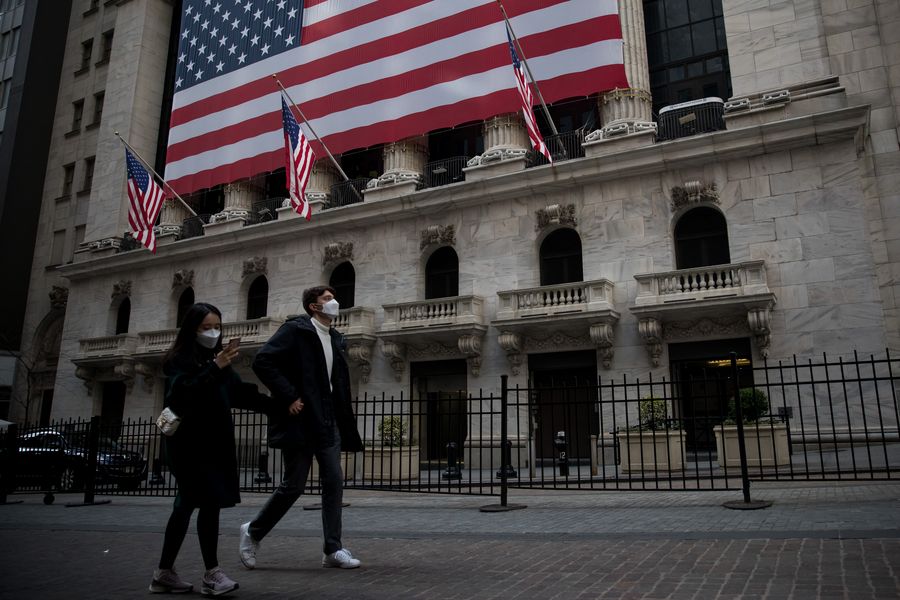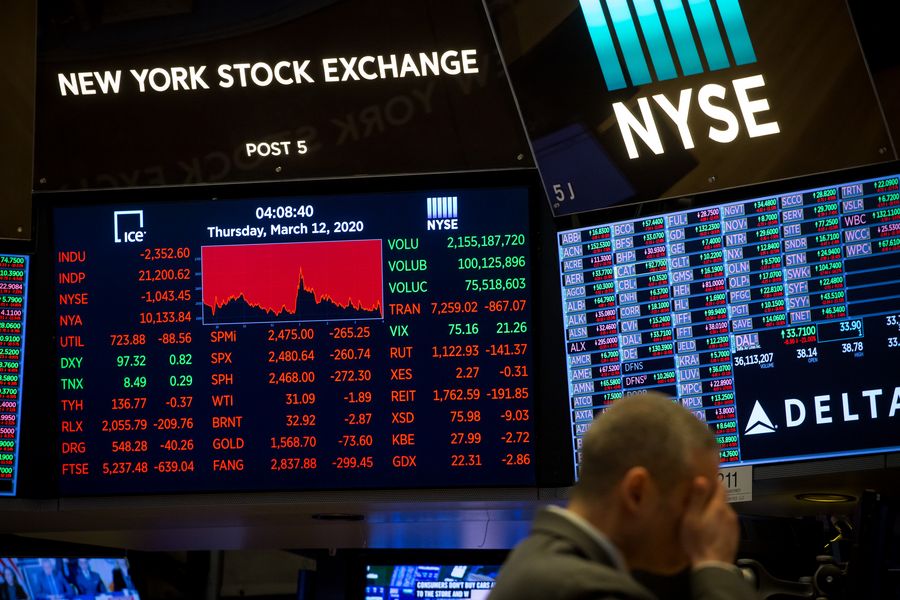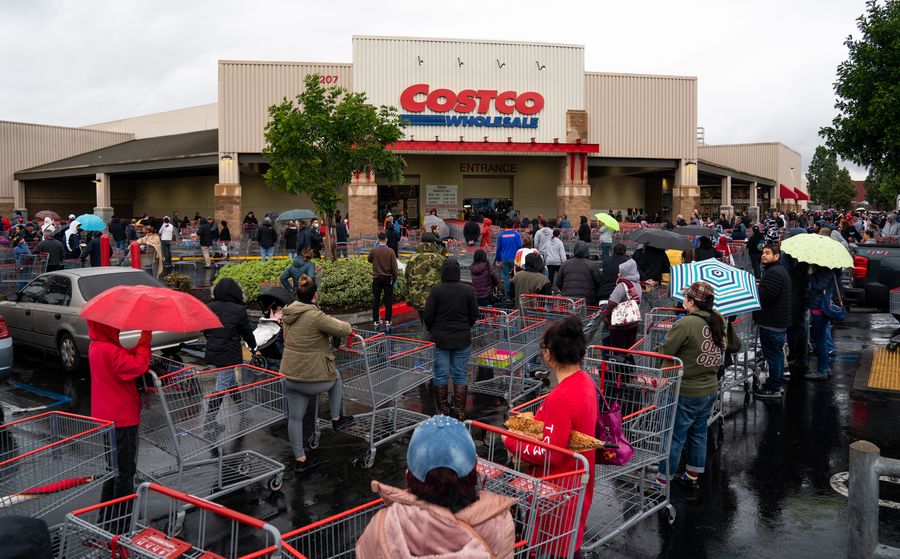The United States is "way-behind" the cycle as yet in getting to terms with confronting the virus's rapid spread. The wider the spread, the greater the damage.
by Xinhua writers Yang Shilong, Chang Yuan, Xiong Maoling
WASHINGTON, March 25 (Xinhua) -- Sitan Chen, a world martial art champion, and his wife Xu Lynn, who live near New York City, made a timely, right decision to move their Tai Chi classes online two weeks ago.
Otherwise, hundreds of their students can hardly continue learning the ancient mind-body practice after the executive order issued by New York State Governor Andrew Cuomo took effect on March 22, putting all of New York "on pause" to curb the further spread of the COVID-19 pandemic.

A screen shows students taking world martial art champion Sitan Chen's online class in New York, the United States, March 23, 2020. (Xinhua)
LIFE IN PRACTICAL STANDSTILL
"We had to make a choice as the situation here worsened day by day. We'd like to let our students proceed with their classes as life is in a practical standstill because of the virus," Lynn told Xinhua via social media app WeChat.
The couple's Tai Chi class is going on at the Sitan Tai Chi and Martial Arts in Syosset, New York, over Zoom, a video calling app, which has become a primary social platform amid the pandemic.
"Thank you Master Lynn. Great to have online classes during this time to stay active. Hope everyone stay healthy and safe!" said Anna Yeung after the Tuesday class.

Amber Yan, world martial art champion Sitan Chen's student, takes online class at home in New York, the United States, March 23, 2020. (Xinhua)
New York is the second state, following California, that endeavored to curb the spread of the novel coronavirus by closing schools, shutting down non-essential businesses and urging residents to stay at home.
Similar directives have been quickly adopted elsewhere in the United States as the coronavirus takes hold at an alarming rate. By Wednesday, the stay-at-home order is effective in as many as 17 states, affecting more than half of the U.S. population of about 330 million.
Due to a "very large acceleration" in infections, the World Health Organization (WHO) said Tuesday that the United States is potentially the next epicenter of the coronavirus pandemic.
"We haven't faced an enemy like we are facing today in 102 years," said Ohio Governor Mike DeWine when announcing the stay-at-home order. "We are at war."

Health workers are seen at a drive-through COVID-19 testing location set up by the Virginia Hospital Center in Arlington, Virginia, the United States, March 19, 2020. (Photo by Ting Shen/Xinhua)
Over 68,000 COVID-19 cases in total have been confirmed in all 50 states plus Washington D.C. and several U.S. territories by Wednesday afternoon, with over 1,000 fatalities, showed data from the Center for Systems Science and Engineering at Johns Hopkins University.
The number of confirmed cases nationwide is growing by around 10,000 on a daily basis, and over 160 patients died on Wednesday, recording the deadliest day of the virus infection.
Major sports events, including the start of the MLB season, the end of NBA season and March Madness NCAA basketball tournaments, have been postponed or outright canceled to prevent large crowds from gathering.
New York City, the hardest hit by the pandemic, confirmed over 17,000 cases by Wednesday afternoon. Broadway theaters have gone dark for the foreseeable future; the New York Stock Exchange has turned into all-electronic trading; while late-night shows, concerts and other public events have been canceled or are playing without spectators.

People walk past a closed broadway theater near Times Square in New York, the United States, March 21, 2020. (Xinhua/Wang Ying)
Many states are faced with a shortage of hospital beds and essential medical supplies, including N95 masks, medical gloves, face shields and gowns.
Mayor Bill de Blasio said Sunday that New York was just 10 days away from running out of medical equipment in fighting the pandemic.
Governor Andrew Cuomo said Tuesday that the New York state needs at least 30,000 ventilators to prepare for the influx of COVID-19 patients expected to come in two to three weeks. The state currently has around 7,000, and "The only way we can obtain these ventilators is from the federal government."
RECESSION ALMOST CERTAIN
A recession for the United States is now almost certain, according to a survey of 34 economists conducted by The Wall Street Journal.
The coronavirus-triggered downturn would last months at least and would in some ways rival the severity of the global financial crisis in 2008, the survey projected.
The U.S. economy is driven mostly by consumer spending on restaurants, hotels, gyms, sports events and concerts, and with much of those shut down, "We could see a 30 percent contraction in the economy in the second quarter," said Edward Alden, Bernard L. Schwartz Senior Fellow at the Council on Foreign Relations, told Xinhua via email in a recent interview.
"The length of the recovery will depend both on the progress of the virus, and on whether many businesses are driven into bankruptcy over the next few months," he added.

Pedestrians wearing face masks walk past the New York Stock Exchange in New York, the United States, March 18, 2020. (Photo by Michael Nagle/Xinhua)
The U.S. Federal Reserve (Fed) announced Monday a plan to purchase U.S. treasuries and agency mortgage-backed securities with no limit to help markets function more efficiently amid coronavirus uncertainty.
The Fed is "doing everything within its ability" to shore up the economy and stave off deeper financial problems, Alden said.
"On the recession risk, yes indeed it is very high. U.S. second quarter GDP numbers are likely to be absolutely terrible and the bleeding may likely continue into the third quarter," Sourabh Gupta, a senior fellow at the Washington-based Institute for China-America Studies, told Xinhua Wednesday.
Wall Street just finished another brutal week with massive losses as investors grappled with fears over potential economic damage by the coronavirus, although it has since recouped some of the losses as the White House and the U.S. Senate have been able to reach agreement on a gargantuan economic stimulus package.
After rounds of negotiations between Democrats and Republicans, the U.S. Senate on Wednesday night passed the 2-trillion-dollar stimulus package to blunt the economic fallout of COVID-19.
Nevertheless, for the week ending March 20, the Dow shed 17.3 percent, the S&P 500 fell 14.98 percent and the Nasdaq lost 12.64 percent. The major averages had their worst weekly performances since the 2008 financial crisis.

A monitor shows the trading information at the New York Stock Exchange in New York, the United States, March 12, 2020. (Xinhua)
Gupta listed "four key reasons" behind the market reactions.
First, the United States is "way-behind" the cycle as yet in getting to terms with confronting the virus's rapid spread, "the wider the spread, the greater the damage" to aggregate demand down the line.
Second, markets are "understandably in panic mode" because the depth of spread and severity of the virus is "as yet unquantifiable," he said.
Third, the late-cycle dynamic and the Fed's easy money policies over the past decade mean that many businesses have become "complacently attuned to carrying large corporate debt burdens on their balance sheets," according to Gupta.
"Now with an aggregate demand shock about to hit their business lines, and bottom lines, markets are trying to make a panicked assessment of profit write-downs and loss adjustment," he explained.
"That said, winding down elevated corporate debt levels is easier than winding down elevated household debt, as was the case in 2008-09," he said. "As such, the balance sheet correction will be swifter but nonetheless will hurt market sentiment in the short term."

A customer pushes a cart while shopping at a supermarket in Oakland, the United States, March 11, 2020. (Photo by Li Jianguo/Xinhua)
Finally, the Fed is "flooding the markets with loose money" and the Congress and the White House are working on multiple fiscal packages, "but this virus-borne aggregate demand shock requires a different set of liquidity and macroeconomic tools from the 2008 global financial crisis," he said.
"The COVID-19 crisis requires a completely different set of interventions," Gupta noted. "The need for a large fiscal stimulus is essential."
"Fiscal policy more than monetary policy needs to carry the burden during this crisis," he said. "But it needs to be targeted well too and cushion livelihoods, small businesses, and industrial sectors that are at greatest risk of economic damage."

Local residents wait in lines outside a Costco supermarket in Los Angeles, the United States, March 14, 2020. (Photo by Qian Weizhong/Xinhua)
As fiscal and monetary packages will lead to a huge spike in the U.S. public debt, he said, it bears noting that U.S. public debt to GDP leapt from 40 percent of GDP in 2009 to 70 percent of GDP in 2012 as a result of the government-stimulated crisis recovery effort and today stands at 80 percent of GDP.
He warned of a sensitive three-digit debt level, saying the Congress and the White House "have a responsibility to set partisanship aside and get design of stimulus right."
U.S. unemployment claims jumped as the coronavirus began to weigh on the economy, official data showed.
In the week ending March 14, U.S. initial jobless claims, a rough way to measure layoffs, came in at 281,000, an increase of 70,000 from the previous week's unrevised level of 211,000.■
(Xinhua reporters Gao Pan, Xu Yuan, Hu Yousong, Liu Jie in Washington and Pan Lijun, Wang Ying, Zhang Mocheng in New York also contributed to the story.)
(Video reporters: Yang Shilong, Hu Yousong, Zhang Mocheng, Xiong Maoling; Video editor: Yang Zhixiang)



